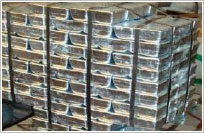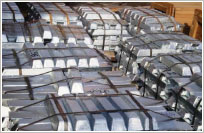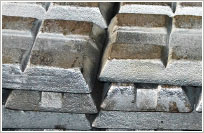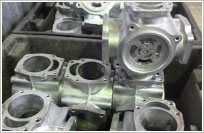Zinc alloys
- NON-FERROUS METALS
- General information
- About us
- Rolled ZINC
- Rolled zinc
- Zinc ingots TSV00
- Zinc TS0A
- Wire Zinc TS1
- Zinc plate
- Zinc wire
- Seam roof zinc-titanium
- Zinc Sheet
- Zinc Alloy TSAM4-1
- Rolled zinc
- Foundry alloys of zinc
- Zinc alloys
- Zinc powder PTS1
- Zink powder PTS2
- Zinc powder PTS3
- Zinc powder PTS4
- Zinc powder
- Zinc granular
- Zinc Protector P-KOTS (shorted)
- Zinc ingots
- Zinc Protector P-REC (non-disconnectable)
- Zinc protectors
- Zinc ingots
Zinc alloys
Already at 100 - 150 degrees zinc easily processed rental, pressing and deep drawing, but at 200 degrees, the metal becomes quite fragile.
Due to these shortcomings in the industry often do not use pure zinc and its alloys.
Zinc-based alloys have a low melting temperature and good flowability. They are easy to process under pressure, can be cut, welded or soldered. Zinc alloys may also be applied to any (metal or non-metallic) surface is produced by chemical or electrochemical method. All the zinc-based alloys retain its positive properties.
Over the mass distribution of zinc alloys obtained in the field of injection molding, which is used for the manufacture of parts in the automotive industry, a variety of household appliances, office equipment and many other industries. This is due to the fact that zinc alloys most technological in handling and allow for thin-walled castings.
Zinc alloys, depending on the application is divided into casting, anti-friction, warping, printing, tread alloys and solders.
Casting zinc alloys (3,5-4,3% Al, 0,6-3,5% Cu, 0,03-0,06% Mg) -has a high fluidity, good fill the form and do not interact with its metal. This property provides thin-walled castings of any, even the most complex shapes.
Anti-friction zinc alloys (9-12% Al, 1-1,5, % Cu, 0,03-06% Mg) - have hard and soft components. Details of such a zinc alloy obtained by treating under pressure or by casting.
Wrought zinc alloys (13-17% Al, 4,5-5% Cu, 0,05% Mg) - similar in properties with brass. Ingots of alloys obtained by casting, and then from these ingots are made sheets, rods and other semi-finished products.
Printing zinc alloys (2,2-7,5% Al, 0,06-4,5% Cu, 1,2-1,8% Mg) - used during casting typographic fonts, this is due to good flowability and high resistance to abrasion alloys.
Sacrificial zinc alloys (0,2-0,7% Al + Mg and Mn additives) applicable for corrosion protection in shipbuilding and industrial sector, given the explosion and fire these alloys.
Solders - such zinc alloys have a very wide range of composition and they are used for soldering of various compositions. These joints have a very high strength, but, unfortunately, low resistance to corrosion. Solder copper-zinc quite durable and, for example, is used for brazing of steel of various grades.
Modern industry is constantly looking for new options for the zinc alloy to improve its qualities.
|
|
|
|
|
|
|
|
|
|
|
|
|
|












